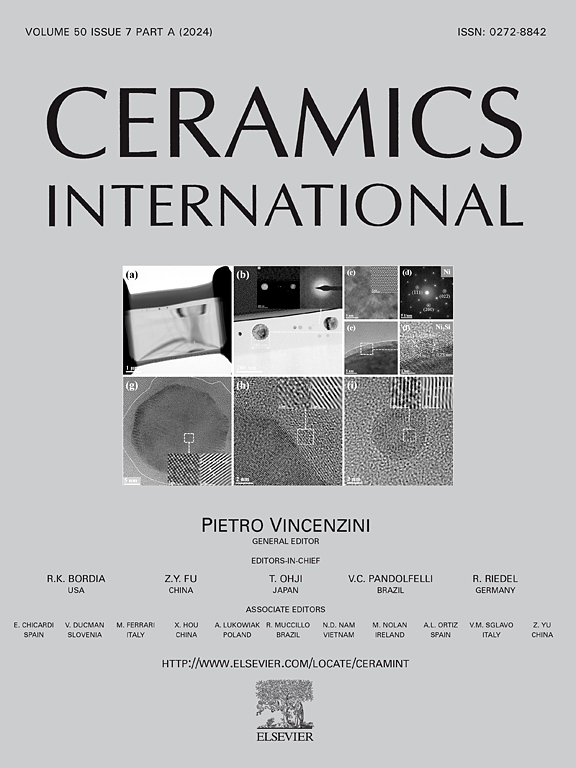Electron-lattice coupling and double exchange effects to improve TCR of La0.67-xNdxCa0.25Sr0.08MnO3 films grown on La0.3Sr0.7Al0.65Ta0.35O3 substrates
IF 5.1
2区 材料科学
Q1 MATERIALS SCIENCE, CERAMICS
引用次数: 0
Abstract
In this study, La0.67−xNdxCa0.25Sr0.08MnO3 (LNCSMO, x = 0.09, 0.10, 0.11, 0.12) films were prepared by sol-gel spin coating method. The results indicate that the LNCSMO film is oriented and grown on a La0.3Sr0.7Al0.65Ta0.35O3 (LSATO) (00l) substrate. In addition, with the increase of Nd3+ content, the Mn-O bond length (dMn-O) and Mn-O-Mn bond angle (θMn-O-Mn) decreases. The concentration ratio of Mn4+ increases firstly and then decreases, and resulting in an enhanced and then weakened double exchange (DE) effect. Measuring the variation of sample resistivity with temperature (ρ-T) using the standard four-probe method. As the content of Nd3+ increases, the metal-insulator transition temperature (Tp) gradually decreases, and the resistivity (ρ) gradually increases. The replacement of Nd3+ makes the peak temperature coefficient of resistivity value (TCRmax) of the material firstly increase and then decrease. At x = 0.11, the TCRmax reaches 34.28 % K−1 at 254.72 K. This provides new insights into the impact of Nd doping on electrical transport properties.
求助全文
约1分钟内获得全文
求助全文
来源期刊

Ceramics International
工程技术-材料科学:硅酸盐
CiteScore
9.40
自引率
15.40%
发文量
4558
审稿时长
25 days
期刊介绍:
Ceramics International covers the science of advanced ceramic materials. The journal encourages contributions that demonstrate how an understanding of the basic chemical and physical phenomena may direct materials design and stimulate ideas for new or improved processing techniques, in order to obtain materials with desired structural features and properties.
Ceramics International covers oxide and non-oxide ceramics, functional glasses, glass ceramics, amorphous inorganic non-metallic materials (and their combinations with metal and organic materials), in the form of particulates, dense or porous bodies, thin/thick films and laminated, graded and composite structures. Process related topics such as ceramic-ceramic joints or joining ceramics with dissimilar materials, as well as surface finishing and conditioning are also covered. Besides traditional processing techniques, manufacturing routes of interest include innovative procedures benefiting from externally applied stresses, electromagnetic fields and energetic beams, as well as top-down and self-assembly nanotechnology approaches. In addition, the journal welcomes submissions on bio-inspired and bio-enabled materials designs, experimentally validated multi scale modelling and simulation for materials design, and the use of the most advanced chemical and physical characterization techniques of structure, properties and behaviour.
Technologically relevant low-dimensional systems are a particular focus of Ceramics International. These include 0, 1 and 2-D nanomaterials (also covering CNTs, graphene and related materials, and diamond-like carbons), their nanocomposites, as well as nano-hybrids and hierarchical multifunctional nanostructures that might integrate molecular, biological and electronic components.
 求助内容:
求助内容: 应助结果提醒方式:
应助结果提醒方式:


